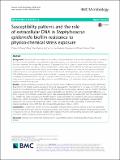| dc.description.abstract | Over 65% of human infections are ascribed to bacterial biofilms that are often highly resistant to antibiotics and host immunity. Staphylococcus epidermidis is the predominant cause of recurrent nosocomial and biofilm-related infections. However, the susceptibility patterns of S. epidermidis biofilms to physico-chemical stress induced by commonly recommended disinfectants [(heat, sodium chloride (NaCl), sodium hypochlorite (NaOCl) and hydrogen peroxide (H2O2)] in domestic and human healthcare settings remains largely unknown. Further, the molecular mechanisms of bacterial biofilms resistance to the physico-chemical stresses remain unclear. Growing evidence demonstrates that extracellular DNA (eDNA) protects bacterial biofilms against antibiotics. However, the role of eDNA as a potential mechanism underlying S. epidermidis biofilms resistance to physico-chemical stress exposure is yet to be understood. Therefore, this study aimed to evaluate the susceptibility patterns of and eDNA release by S. epidermidis biofilm and planktonic cells to physico-chemical stress exposure. | en_US |

